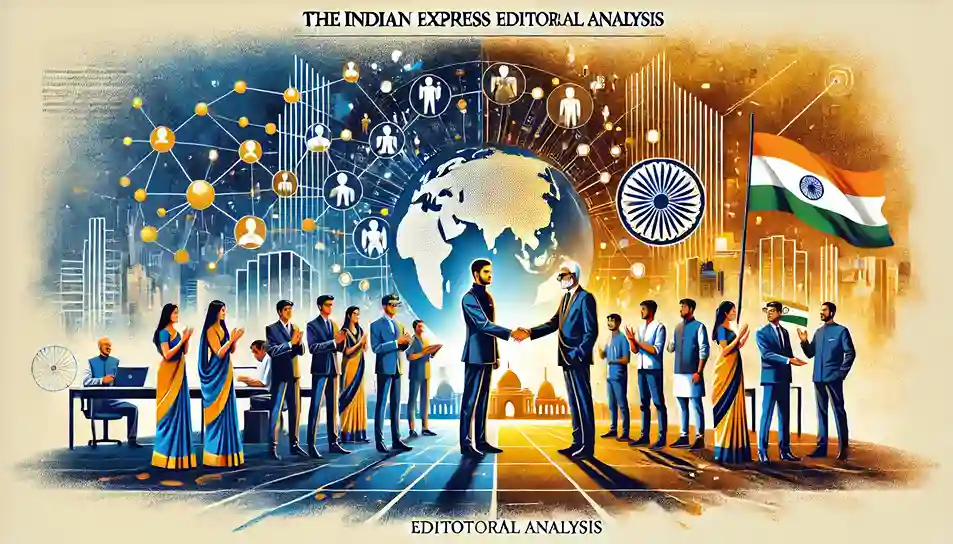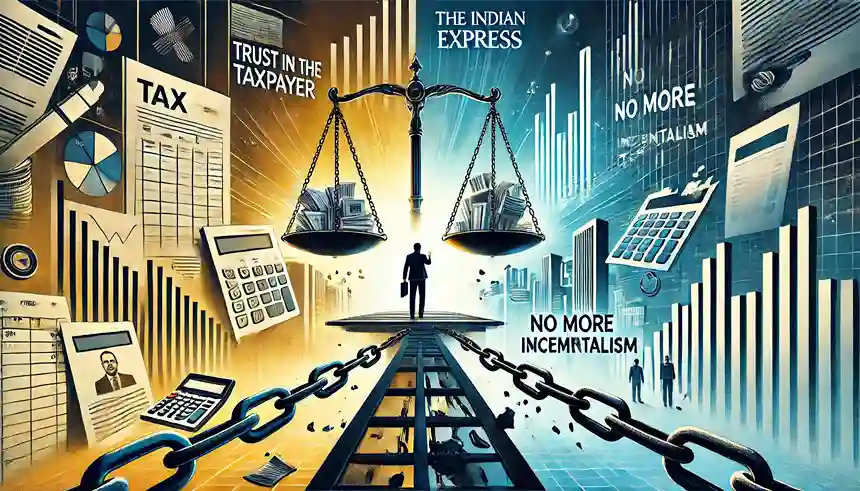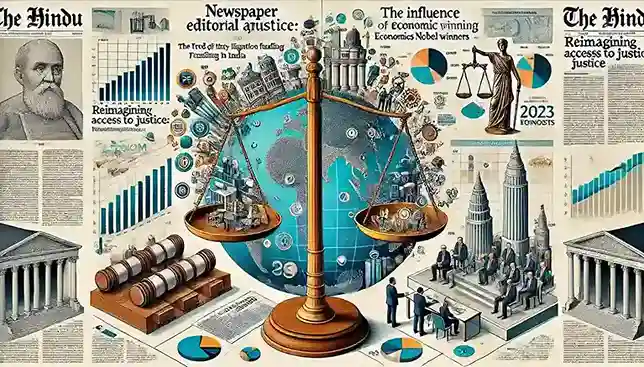Analysis of The Hindu Editorial 1: Reimagining access to justice
Context
In a country where “justice for all” is a constitutional promise, Third-Party Litigation Funding (TPLF) has emerged as a potential solution to bring that vision closer to reality. This innovative legal mechanism holds the potential to make justice more accessible, especially for those who have long been shut out of the courtroom due to financial constraints.
Introduction
Across India’s vast legal landscape, from the iconic Supreme Court in Delhi to the humble district courts in rural areas, a silent transformation is taking shape. Unlike movements to reform outdated colonial laws or speed up legal procedures, this change centers on a more fundamental question: who pays the price for justice? In this evolving scenario, Third-Party Litigation Funding (TPLF) has emerged as a crucial tool that could democratize access to justice by covering legal expenses for those who cannot afford them.
This article explores how TPLF could revolutionize access to justice in India and the potential it holds for addressing long-standing inequalities in the legal system.
- Analysis of The Indian Express Editorial – February 13, 2025

- Analysis of The Indian Express Editorial – February 12, 2025

- Analysis of The Indian Express Editorial – December 31, 2024

- Analysis of The Indian Express Editorial – December 19, 2024

- Analysis of The Indian Express Editorial – December 18, 2024

Real-Life Struggles: The Need for TPLF
Imagine a small shop owner in Pune battling an e-commerce giant or a group of villagers in Odisha fighting a polluting industrial company. These are not just symbolic David versus Goliath stories—they reflect real struggles, where the quest for justice often halts before it even begins. Why? Not because the cases lack merit, but because the plaintiffs cannot afford the astronomical costs of litigation.
TPLF addresses this financial hurdle by allowing third-party investors to fund legal cases in exchange for a share of the eventual settlement or court award. The significance of this model is particularly stark in a country like India, where legal battles often drag on for years, and the cost of pursuing a case can be prohibitive for many.
What is Third-Party Litigation Funding (TPLF)?
TPLF involves external investors who fund legal cases for financially disadvantaged litigants, offering them a lifeline. In return, these funders take a portion of the winnings, should the case succeed. While this model has been controversial in many countries, it is gradually being recognized in India as a potential “equalizer” in the courtroom.
Why TPLF is Gaining Traction in India:
- High Litigation Costs: As the expenses for legal representation and expert testimony continue to rise, TPLF provides a viable solution to bridge the financial gap.
- Mounting Case Backlogs: India’s courts are notoriously overburdened, with millions of pending cases. TPLF offers a way to ensure that even those without deep pockets can have their day in court.
TPLF as a Potential Equalizer: The Supreme Court’s Stance
The Indian Supreme Court’s decision in Bar Council of India v. A.K. Balaji marked a turning point for TPLF in the country. The Court ruled that third-party litigation funding is permissible, as long as lawyers themselves are not the funders. This ruling builds on the legal foundations laid by the 1876 Privy Council judgment in Ram Coomar Coondoo v. Chunder Canto Mookerjee, which established that old English laws prohibiting such funding do not apply to India.
The Court recognized TPLF’s potential as an equalizer, allowing litigants with valid claims to challenge wealthy corporations or institutions, leveling the playing field in Indian courtrooms.
Potential Ripple Effects of TPLF
TPLF’s potential impact could be felt across various sectors and regions of India. Some of the scenarios where TPLF could be a game-changer include:
- Consumer Protection: Groups of consumers in urban centers like Mumbai could take on corporations involved in food adulteration.
- Tech Startups: Small companies in Bengaluru could defend themselves against larger industry players trying to stifle competition.
- Environmental Justice: Tribal communities, supported by NGOs, could challenge mining companies without fear of financial ruin.
- Workers’ Rights: Factory workers facing unfair labor practices could finally seek justice.
In specialized legal fields, such as medical malpractice and intellectual property rights (IPR), where expert witnesses are often required, TPLF could make the difference between a case moving forward or being abandoned due to lack of funds. It could also breathe new life into Public Interest Litigation (PIL), a powerful tool for social change that has shaped Indian jurisprudence since the 1980s.
Concerns and the Need for Regulation
While TPLF offers great promise, it also raises significant concerns. One of the main criticisms is that funders may focus solely on cases that offer the highest financial returns, potentially ignoring socially important but less profitable cases. Furthermore, questions arise about how much influence funders should have over the legal strategy of the cases they bankroll.
Several Indian states, including Maharashtra, Gujarat, and Madhya Pradesh, have already taken preliminary steps by amending civil procedure codes to recognize third-party financing of litigation. However, there is still an urgent need for a national framework to regulate TPLF.
Key Regulatory Considerations:
- Licensing Requirements: Should litigation funders be licensed as financial service providers?
- Oversight: Establishing a dedicated regulatory body to oversee funders and ensure ethical practices.
- Transparency: Mandatory disclosure of funding agreements to protect the rights of the litigants.
- Cap on Profits: Ensuring that funders’ earnings are capped to prevent exploitation.
Broader Implications of TPLF
A well-regulated TPLF system could have profound implications for India’s legal landscape. It could strengthen consumer rights, enhance environmental protections, and hold institutions more accountable. Given the enormous backlog of cases—over 80,000 at the Supreme Court level and around 40 million nationwide—TPLF could offer a practical solution to expedite justice for millions of people.
Structuring a Regulatory Framework for TPLF
As India contemplates how best to regulate TPLF, several critical issues must be addressed:
- Licensing Funders: Should litigation funders be required to obtain licenses similar to financial institutions?
- Capital Adequacy: Ensuring that funders have enough capital to cover litigation expenses and adverse costs.
- Court Involvement: Determining how much oversight courts should have in approving or reviewing TPLF arrangements.
Regulatory examples from other jurisdictions, such as Hong Kong’s Code of Practice for Third Party Funding in Arbitration (2019), could serve as useful guides for India. This code requires the disclosure of funding details, liability for costs, and the degree of funder control in legal strategies.
Way Forward
The path forward for TPLF in India involves a delicate balance between expanding access to justice and maintaining the integrity of the judicial process. Crafting a comprehensive regulatory framework will be essential to ensure that TPLF promotes fairness without creating new avenues for exploitation.
By embracing this innovative model, India has the opportunity to not only democratize justice but also to set a global benchmark for balancing financial innovation with the fundamental right to legal recourse.
- [PDF] “Arihant Computer Awareness Book 1” – Free Download
![[PDF] Arihant Computer Book.pdf” – Free Download for Competitive Exams](https://savepdf.in/wp-content/uploads/2025/04/PDF-Arihant-Computer-Book.pdf-–-Free-Download-for-Competitive-Exams-1040x650.webp)
- [PDF] The Pragmatic Programmer by David Thomas and Andrew Hunt

- [PDF] Structure and Interpretation of Computer Programs
![[PDF] Structure and Interpretation of Computer Programs](https://savepdf.in/wp-content/uploads/2024/12/PDF-Structure-and-Interpretation-of-Computer-Programs-1157x650.webp)
- [PDF] Computer Fundamentals by Anita Goel – Free Download
![[PDF] Computer Fundamentals by Anita Goel – Free Download](https://savepdf.in/wp-content/uploads/2024/11/Computer-FundameComputer-Fundamentals-by-Anita-GoelComputer-Fundamentals-by-Anita-Goelntals-by-Anita-Goel-1156x650.png)
- [PDF] – Mainframe Systems Programming: An Introduction – Download Now
![Mainframe Systems Programming: An Introduction – [PDF]](https://savepdf.in/wp-content/uploads/2024/10/PDF-–-Mainframe-Systems_20241004_162243_0000-1156x650.webp)
Conclusion
As India takes active steps toward reimagining its legal system, Third-Party Litigation Funding presents both a challenge and an opportunity. With careful regulation, TPLF can help bridge the financial gap that keeps many from pursuing justice, fostering a more equitable legal system for all.
Analysis of The Hindu Editorial 2: Spotlighting the work of the Economics Nobel winners
Context
The work of Daron Acemoglu, Simon Johnson, and James Robinson (AJR), recipients of the 2023 Economics Nobel, has shed new light on how institutions play a crucial role in shaping economic development. Their research argues that strong institutions are vital for sustainable growth, but not without criticism for favoring Western models. This article explores the key contributions of AJR, the debate surrounding their work, and the broader implications for global development.
Introduction
In the 17th and 18th centuries, a global shift known as The Great Divergence occurred, widening the economic and political gap between the West and the East. As industrialization allowed Western Europe to dominate, they not only reaped economic benefits but also projected their political power across continents.
One of the key insights from research into this divergence is how institutions established during the colonial era continue to influence nations, long after achieving independence. The institutions set in place, whether extractive or inclusive, have left lasting legacies that shape modern economic outcomes.
- [PDF] Kiran SSC 10600+ General Awareness Book English
![[PDF] Kiran SSC General Awareness Book English](https://savepdf.in/wp-content/uploads/2024/12/PDF-Kiran-SSC-10600-General-Awareness-Book-English-1156x650.webp)
- [PDF] – Manorama Yearbook 2025: A Comprehensive Guide to Knowledge and Exam Success

- [PDF] Blackbook 25000+ GA English Medium
![[PDF] Blackbook 25000+ GA English Medium](https://savepdf.in/wp-content/uploads/2024/11/PDF-Blackbook-25000-GA-English-Medium-1156x650.webp)
- [PDF] Reasoning Made Easy – Download Now
![[PDF] Reasoning Made Easy](https://savepdf.in/wp-content/uploads/2024/11/Reasoning-Made-Easy-1156x650.webp)
- [PDF] Police Recruitment Challenger – Download Now
![[PDF] Police Recruitment Challenger](https://savepdf.in/wp-content/uploads/2024/11/Police-Recruitment-Challenger-1156x650.webp)
The Role of Institutions in Development
Understanding Institutions
This year’s Nobel winners in economics—Acemoglu, Johnson, and Robinson—emphasize the importance of institutions in determining the trajectory of a country’s development. Institutions, according to their research, are essentially the “rules of the game” that guide human behavior, acting as a safeguard against abuses of power and promoting fairness in society. They create incentives that either restrict or encourage economic and political activity, shaping the course of a nation’s future.
Types of Institutions: Extractive vs. Inclusive
AJR’s work draws a stark contrast between extractive and inclusive institutions:
- Extractive Institutions: These systems concentrate power and wealth in the hands of a small elite, offering limited incentives for broader participation in economic growth. While they may generate wealth, they fail to distribute it equitably, leading to long-term stagnation.
- Inclusive Institutions: These systems, by contrast, encourage wider participation and ensure that the benefits of economic progress are shared across society. They foster innovation, protect property rights, and promote a level playing field, enabling long-term prosperity.
AJR’s research argues that the development trajectories of countries across the world have been shaped by whether they inherited extractive or inclusive institutions. Colonial powers often imposed extractive systems in regions such as Sub-Saharan Africa and South Asia, while settler colonies like the U.S. and Australia saw more inclusive structures emerge.
The Causal Link Between Institutions and Economic Growth
One of AJR’s most important contributions is demonstrating a direct link between institutional structures and economic growth. Their landmark study involved analyzing the mortality rates of European settlers in various regions and how this affected the type of institutions established.
For instance, in temperate regions like the U.S. and Australia, where European settlers could live relatively disease-free, they established inclusive institutions that promoted long-term investment and growth. In tropical colonies, however, high mortality rates led to the creation of extractive institutions, designed to exploit resources without long-term planning.
Research Methodology: Natural Experiments
A key strength of AJR’s research lies in their use of natural experiments. Unlike controlled laboratory settings, economists often have to rely on real-world events to study cause-and-effect relationships. AJR’s innovation was to use historical events—like the variation in settler mortality rates—to analyze how institutions shaped economic outcomes over time.
By comparing different regions that were randomly exposed to distinct types of colonial institutions, they were able to show that countries with extractive institutions experienced lower long-term growth, while those with inclusive institutions enjoyed sustained development.
Insights from India: Colonial Legacies and Modern Development
AJR’s work has had a profound influence on studies of colonial legacies in India. Scholars like Abhijit Banerjee and Lakshmi Iyer have applied AJR’s framework to examine the long-term effects of British colonial rule on Indian economic development.
- Land Tenure Systems: In their 2005 study, Banerjee and Iyer found that regions in India where the British introduced landlord-based land tenure systems still struggle with lower agricultural productivity and investment. These extractive systems continue to hinder development today.
- Direct vs. Indirect Rule: In a separate study, Lakshmi Iyer (2010) showed that areas under direct British rule had fewer schools, health centers, and infrastructure compared to regions under indirect rule. This disparity highlights how the institutional framework imposed during colonial times continues to affect development today.
Institutions and Political Power
A central theme in AJR’s work is the link between economic institutions and political power. They argue that the structure of a country’s institutions is shaped by its distribution of political power, which can be either de jure or de facto.
- De jure power: This refers to formal, legal power, like the authority of the U.S. President, Joe Biden, which is tied to his office.
- De facto power: This is informal power, often exercised by individuals regardless of official roles, such as Teodoro Obiang Nguema, the long-serving president of Equatorial Guinea, whose rule is maintained through coercive means.
Reforming extractive institutions is difficult because those in power have little incentive to change systems that benefit them. AJR’s research highlights how groups with political power use their influence to maintain or increase control over resources, preventing meaningful reform.
Broader Implications and Criticisms of AJR’s Work
Shifts in Economic Thinking
AJR’s research came to prominence during a shift in economic thinking, moving away from prescriptive policies like the Washington Consensus toward more diagnostic, context-specific approaches. Their work encouraged economists to look beyond one-size-fits-all solutions and instead consider the unique institutional contexts of each country.
Criticism: Privileging Western Institutions
Despite its influence, AJR’s work has faced criticism for privileging Western liberal institutions as the gold standard for development. Scholars like Yuen Yuen Ang argue that Western nations, including the U.S., were not always paragons of inclusive institutions, pointing to their histories of slavery, indigenous displacement, and exclusionary practices. Critics also highlight that AJR’s framework does not fully address the complexities of colonialism and capitalism, particularly in non-Western contexts.
Conclusion
The work of Daron Acemoglu, Simon Johnson, and James Robinson has reshaped our understanding of how institutions shape economic growth. By illustrating the long-lasting effects of colonial institutions, their research has provided valuable insights into why some countries prosper while others stagnate.
However, as their critics point out, the story of development is more complex than a simple transfer of Western institutional models. As scholars continue to build on AJR’s work, it’s clear that a deeper, more nuanced understanding of institutions—one that accounts for historical, political, and cultural contexts—will be necessary to fully grasp the drivers of global development.

